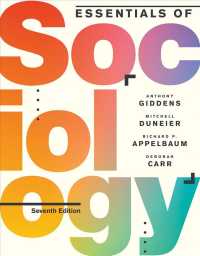- ホーム
- > 洋書
- > 英文書
- > Computer / General
Full Description
The six-volume proceedings set LNAI 15919, 15920, 15921, 15922, 15923 and 15924 constitutes the refereed proceedings of the 18th International Conference on Knowledge Science, Engineering and Management, KSEM 2025, held in Macao, China during August 4-7, 2025.
The 106 papers and 66 short papers are included in these proceedings were carefully reviewed and selected from 354 submissions. They focus on all aspects of the exchange of research in artificial intelligence, data science, knowledge engineering, AI safety, large language models, and related frontier areas.
Contents
.- INDRE: An Interpretable News Driven Risk Evaluation Model.
.- Efficient Transductive Few-Shot Learning with Active Learning for Imbalanced Data.
.- Parallel FHE-Based Neural Network Inference with Knowledge Distillation for Efficient Privacy-Preserving Image Classification.
.- MatSciES: Automated Knowledge Extraction and Summarization from Materials Science Literature with Large Language Models.
.- A Robust Video Steganography Method Based on Multi-Scale Decomposition and Invertible Networks.
.- IR-SDTNet: an infrared small target detection network based on denoising enhancement.
.- Blockchain-Enhanced Copyright Protection for Fashion Industry: A DBAE-Net Based and Traceable Image Similarity Detection Scheme.
.- Mixture of Experts Enhanced Heterogeneous Graph Transformer.
.- CertBA: a Decentralized Authentication Scheme via Blockchain and Dynamic Cryptographic Accumulator.
.- Adaptive Capsule Graph Neural Network with Attention Mechanism for Parathyroid Glands Detection.
.- HGC: A Hybrid Method Combining Gravity Model and Cycle Structure for Identifying Influential Spreaders in Complex Networks.
.- Code Refactoring with ChatGPT: Analysis Based on Real and Synthetic Extract Method Opportunities.
.- A Robust Data Watermarking Method Based on Secret Sharing and GAN for Digital Elevation Model.
.- MOAT: Federated Learning-Based Method for Improved Detection of IoT Botnets.
.- In-context Contrastive Learning for Temporal Knowledge Graph Reasoning.
.- Emotion-Aware Knowledge Tracing: Enhancing Student Performance Prediction with Multi-Head Emotional Attention and Dynamic Gating.
.- Mask-guided Visual Text Transformer for Radiology Reports Representation Learning.
.- MCIGLE: Multimodal Exemplar-Free Class-Incremental Graph Learning.
.- MTCA-ViT: Multi-modal Temporal Contrastive Vision Transformer for Depression Detection.
.- SGCoT:Self-Generating Chain-of-Thought for Discipline Classification.
.- Learning Interaction-Aware and Neighborhood Semantic-Enhanced Embedding for Link Prediction.
.- PromptPilot: Autonomous Prompt Optimization via Genetic Particle Filtering and Dynamic Exploration.
.- A Unified Computation Framework of Lattices in Hierarchical Data Analysis.
.- Generating Event-oriented Attribution for Movies via Two-Stage Prefix-Enhanced Multimodal LLM.
.- Multi-scale Masked Transformer for Robust Point Cloud Registration.
.- Expert Data - assisted Diagnosis: An INFO - iTransformer - XGBoost Combined Discriminative System for Prenatal Diagnosis of Fetal Congenital Heart Disease.
.- Temporal Knowledge Graph Reasoning Based on Historical Statistical Reward Mechanism.
.- Optimized DFA-based URL Filtering for P4 Programmable Switches.
.- Improving Mongolian-Chinese Translation Quality using Noise-Enhanced mBART.
.- RMNS: Robust Hyper-Relational Link Prediction Model Based on Multi-Level Negative Sampling.
.- HG-GIN: Double layer attention graph isomorphism network based on hybrid neighborhood.
.- Matching Ancient Dunhuang Manuscripts Based on Multi-dimensional Feature Fusion.
.- NexaFusion: Integrating Multi-team Collaboration for High-Impact Outcomes.
.- Comprehensive Evaluation of Large Language Model Responses : A Multi-Factor Scoring System.
.- Service Area Vehicle Flow Prediction Model for Highway Service Areas Based on Gravity Model Quadratic Assignment.
.- Multi-Agent Collaborative Framework with Few-Shot CoT for Threat Detection.
.- CombDE: Direct-Distillation combined with Self-Distillation for Knowledge Graph Embeddings.
.- Rethinking Lightweight and Efficient Human Pose Estimation with Star Operation Reconstruction.
.- Comparing large language model-based prompt engineering strategies with feature engineering strategies for complex word identification.
.- DARIS: Dynamic Adaptive Refinement of Interaction Sequence for Sequential Recommendation.
.- PolyBERT: Fine-Tuned Poly Encoder BERT-Based Model for Word Sense Disambiguation.
.- FedDYS: Federated Learning Based on Local Regularization against Data Heterogeneity.








